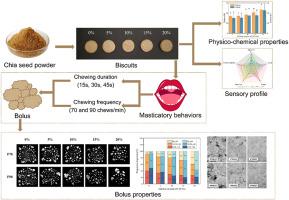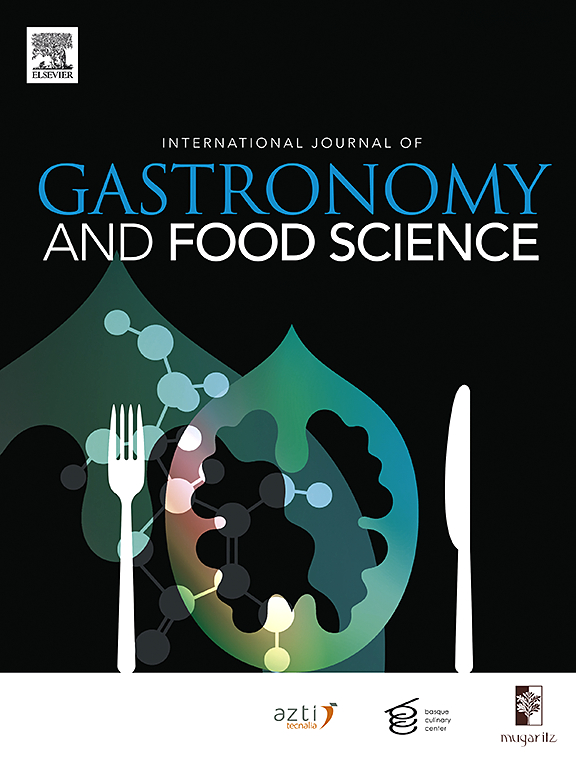Effect of masticatory behavior on the characteristics of biscuit bolus with different amounts of chia seed powder without compromising taste
IF 3.2
2区 农林科学
Q2 FOOD SCIENCE & TECHNOLOGY
International Journal of Gastronomy and Food Science
Pub Date : 2024-10-15
DOI:10.1016/j.ijgfs.2024.101038
引用次数: 0
Abstract
This study investigated the impact of masticatory behavior, including variations in chewing duration (D) and chewing frequency (F), on the bolus characteristics of biscuits with different chia seed powder (CSP) additions. Five distinct biscuits were prepared with varying amounts of CSP (0%, 5%, 10%, 15%, and 20%, w/w) and their physicochemical indexes and sensory properties were conducted. Subsequently, six types of bolus were obtained under different conditions of chewing duration (15, 30, or 45s) and chewing frequencies (70 or 90 times per minute). The moisture content, texture properties, and in vitro starch digestion of bolus were also determined. The findings indicated a significant decrease in the spread ratio, with a reduction of approximately 25% in biscuits enriched with 20% (w/w) CSP compared to the control (0%). And the 15% added CSP biscuits had the highest overall acceptance rating. After chewing, the particle size decreased significantly (p < 0.05), with increased surface inhomogeneity and a decline in rapidly digestible starch (RDS) levels. The moisture content, salivary uptake, and resistant starch (RS) of bolus chewed for a long duration (D45) were at least 1.3 times higher than those chewed for a short duration (D15). Nevertheless, the salivary flow rate and RDS were found to be significantly lower. Changes in chewing frequency for the bolus with CSP did not significantly alter the bolus texture and image texture properties. However, the discomfort associated with high-frequency reduced the saliva flow rate. This study discusses how CSP addition and masticatory behavior affect the characteristics of CSP biscuit bolus, providing insights for innovative chia seed nutritious food research and understanding consumer masticatory behavior.

在不影响口感的前提下,咀嚼行为对添加不同数量奇异籽粉的饼干脆饼特性的影响
本研究调查了咀嚼行为(包括咀嚼持续时间(D)和咀嚼频率(F)的变化)对添加了不同奇异籽粉(CSP)的饼干的栓塞特性的影响。研究人员制备了五种不同奇异籽粉添加量(0%、5%、10%、15%和 20%,w/w)的饼干,并对其理化指标和感官特性进行了研究。随后,在不同的咀嚼时间(15、30 或 45 秒)和咀嚼频率(每分钟 70 或 90 次)条件下,获得了六种类型的脆饼。此外,还测定了脆饼的水分含量、质地特性和体外淀粉消化率。研究结果表明,与对照组(0%)相比,添加了 20%(重量比)CSP 的饼干的铺展率明显下降了约 25%。而添加了 15%CSP 的饼干的总体接受度最高。咀嚼后,饼干的粒度明显减小(p < 0.05),表面不均匀度增加,快速消化淀粉(RDS)含量下降。长时间(D45)咀嚼栓剂的水分含量、唾液吸收率和抗性淀粉(RS)至少是短时间(D15)咀嚼栓剂的 1.3 倍。然而,唾液流速和抗性淀粉含量却明显较低。改变咀嚼含 CSP 药丸的频率并不会明显改变药丸质地和图像质地特性。然而,高频率带来的不适感降低了唾液流速。本研究讨论了添加 CSP 和咀嚼行为如何影响 CSP 饼干脆饼的特性,为奇异籽营养食品的创新研究和了解消费者的咀嚼行为提供了启示。
本文章由计算机程序翻译,如有差异,请以英文原文为准。
求助全文
约1分钟内获得全文
求助全文
来源期刊

International Journal of Gastronomy and Food Science
Social Sciences-Cultural Studies
CiteScore
5.30
自引率
10.50%
发文量
170
审稿时长
45 days
期刊介绍:
International Journal of Gastronomy and Food Science is a peer-reviewed journal that explicitly focuses on the interface of food science and gastronomy. Articles focusing only on food science will not be considered. This journal equally encourages both scientists and chefs to publish original scientific papers, review articles and original culinary works. We seek articles with clear evidence of this interaction. From a scientific perspective, this publication aims to become the home for research from the whole community of food science and gastronomy.
IJGFS explores all aspects related to the growing field of the interaction of gastronomy and food science, in areas such as food chemistry, food technology and culinary techniques, food microbiology, genetics, sensory science, neuroscience, psychology, culinary concepts, culinary trends, and gastronomic experience (all the elements that contribute to the appreciation and enjoyment of the meal. Also relevant is research on science-based educational programs in gastronomy, anthropology, gastronomic history and food sociology. All these areas of knowledge are crucial to gastronomy, as they contribute to a better understanding of this broad term and its practical implications for science and society.
 求助内容:
求助内容: 应助结果提醒方式:
应助结果提醒方式:


